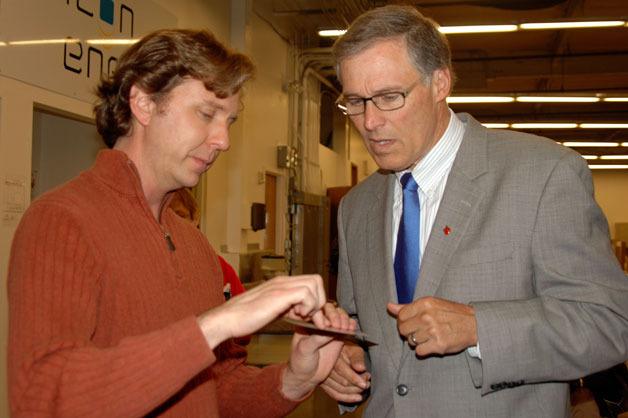MARYSVILLE — U.S. Rep. Jay Inslee has written about the potential for a clean energy economy in America, and on Oct. 21, the Democratic candidate for Washington state governor got a firsthand look at how one local company is striving to make solar energy efficient and accessible.
Silicon Energy became the state’s first solar panel manufacturer when it started production at the Arlington Airport in 2009, and when the demand for its distinctive panels necessitated new equipment and a higher capacity for growth than they’d expected, it moved to Marysville in 2010.
Gary Shaver, president and CEO of Silicon Energy, greeted Inslee at the company’s Marysville plant on Oct. 21, providing him with a guided tour that started with an explanation of what sets Silicon Energy’s solar panels apart from their competition.
“There’s no wires showing, either front or back,” Shaver told Inslee. “At the same time, they can be accessed easily,” he added, sliding back one of the black metal plates, on the sides of the bonded double-panes of glass laminate holding the solar panels within, to reveal the wiring.
Shaver noted that Silicon Energy’s panels can be mounted on roofs, on the sides of buildings, on car ports or as standalone modules, with durability enough to withstand snow or wind. He then invited Inslee to jump up and down on one of the encased panels, which Shaver estimated has withstood similar tests from approximately 2,000 people, some weighing as much as 300 pounds.
When Inslee asked for further evidence of the panels’ durability in the long term, Shaver reported that, out of a group of half a dozen solar companies whose products have been tested continuously by the U.S. Department of Energy’s National Renewable Energy Laboratory since November of 2009, Silicon Energy is the only one whose modules have not yet failed.
“We beat the best in the world,” Shaver said, elaborating on how NREL put all the companies’ panels through simulated aging, subjecting them to 85 percent humidity and temperature cycles of 85 to minus 4 degrees Celsius. “The other panels heated up and lost electrical efficiency, while our panels stayed evened out and had a negligible performance drop, even after 60 years of simulated aging.”
Inslee approved of Silicon Energy’s policy of shopping for parts as close to home possible, which he asserted was deserving of a greater incentive benefit. The metal work for the panel modules is made in Seattle, while the glass comes from Washington.
“What’s your take on what happened to Solyndra?” Inslee asked.
“They worked with the Department of Energy, but it was the wrong approach,” Shaver said. “They did it top-down. The government should provide incentives, like Washington, and guidance, but they should force us to be innovative without strangling us.”
Shaver touted the minimal environmental impacts of Silicon Energy’s panel modules, which use no heavy metals and are designed to be long-lived to help cut down on the number of them that will need to be disposed over time.
“You can put these modules into landfills without anything getting into the water supply or the soil,” Shaver said.







